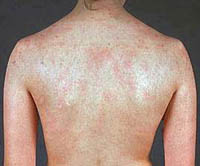You are here:
Allergies

Allergies - A Global Problem
Whether it's eggs, nuts, dairy products or substances in clothing or cosmetics - certain foods or everyday products can cause allergies in some people. Allergies represent a major health, social, and economic problem worldwide. They affect the quality of life of a considerable part of the population: Around a quarter of the population in Europe is allergic to at least one chemical1,2. Around four percent of children and adults in Germany suffer from a food allergy3,4, and many young people and adults suffer from allergic reactions of the respiratory or gastrointestinal tract.
The Role of the BfR Concerning Allergies
There are still many unanswered questions about the development and triggering of allergies as well as the immunological processes involved. One thing is certain: Allergies can be avoided if contact with allergens is prevented. Therefore, knowledge about allergens and their occurrence is very important. As part of its risk assessment, risk communication, scientific cooperation (including national, European and international institutes, universities, and authorities such as the European Chemicals Agency (ECHA)) as well as with its own research, the BfR helps to ensure consumers are better protected against allergenic substances in everyday products and food. Above all, the BfR identifies sources of danger that may cause or trigger allergies and assesses the resulting risks.
The Areas of the BfR that Deal with Allergies
The BfR deals with the subject of allergies from very different perspectives:
- Effect-based Analytics and Toxicogenomics
- Nutritional Risks, Allergies and Novel Foods
- Toxicology of Products and their Safe Use
- Coordination and Overall Assessment
- Safety of Chemicals
- Dermatotoxicology
- Strategies for Toxicological Assessments
- Alinaghi, F., Bennike, N. H., Egeberg, A., Thyssen, J. P. & Johansen, J. D. Prevalence of contact allergy in the general population: A systematic review and meta-analysis. Contact Dermatitis 80, 77-85, doi:10.1111/cod.13119 (2019).
- Diepgen, T. L. et al. Prevalence of contact allergy in the general population in different European regions. Br J Dermatol 174, 319-329, doi:10.1111/bjd.14167 (2016).
- Worm, M. et al. Update of the S2k guideline on the management of IgE-mediated food allergies. Allergol Select 5, 195-243, doi:10.5414/ALX02257E (2021).
- Sicherer, S. H. & Sampson, H. A. Food allergy: A review and update on epidemiology, pathogenesis, diagnosis, prevention, and management. J Allergy Clin Immunol 141, 41-58, doi:10.1016/j.jaci.2017.11.003 (2018).
Opinion
(9)Press releases
(13)Communication
(3)| Date | Title | Size |
|---|---|---|
|
29.03.2021 Communication No 011/2021 from the BfR
|
When the immune system overreacts - schoolgirls and a BfR scientist talk about allergies |
143.7 KB
|
|
24.09.2020 BfR Opinion No 044/2020
|
Food allergy caused by insects? |
136.9 KB
|
|
21.07.2020 BfR Communication No. 031/2020
|
Allergic reaction: how the immune system identifies nickel |
131.8 KB
|
